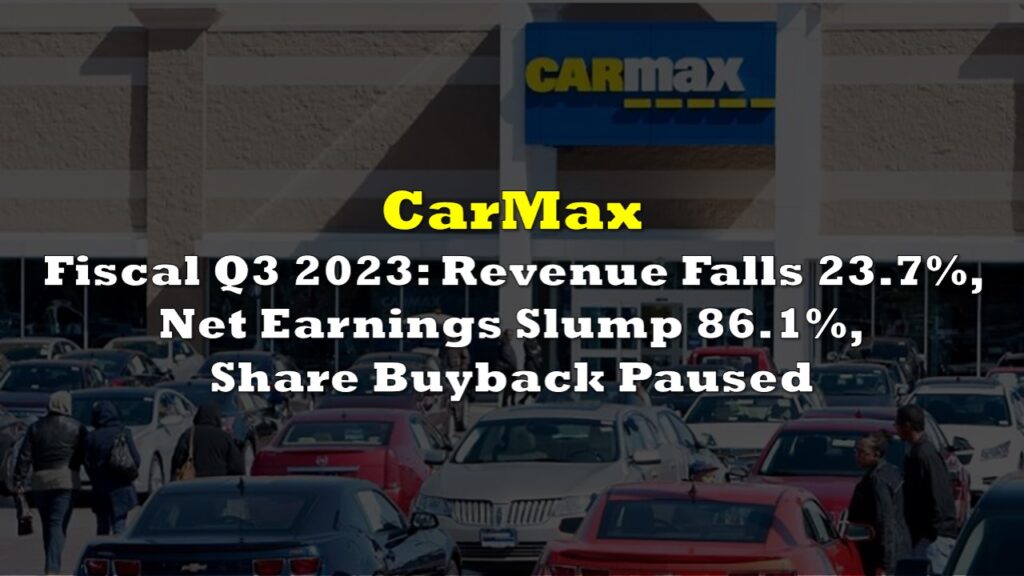On Thursday, CarMax, Inc. (NYSE: KMX), the U.S.’s largest retailer of used cars, reported disappointing used car sales results for the quarter ended August 31, 2022. CarMax’s unit sales of used cars declined 6.4% in the quarter; its comparable store unit sales results were even worse, down 8.3%. In turn, CarMax’s stock plunged a stunning 24%, its biggest one-day loss in 22 years. CarMax’s market valuation was cut by US$3.3 billion.
The specifics of CarMax’s results are actually worse than the headline numbers and augur poorly for future quarters. The company said comp-store sales were down only in the low single digit percent range in June, but then declined sharply in July and August for a blended average of -8.3%. Phrased succinctly, high used car prices, coupled with the rising costs of financing, are creating a “buyers’ strike.”
The quarter ended August 31, 2022 represents the third successive quarter where the physical quantity of used cars fell on a year-over-over basis. The results suggest that the pandemic used car boom is over.

Year-over-year changes in unit sales in quarters before August 2021 are not shown because they are biased too much by the early stages of the pandemic. For example, unit sales in the quarter ended May 2021 were up 100.6% versus the period ending in May 2020.
Used car sales and prices boomed during COVID-19, as supply chain issues, particularly related to semiconductors, limited the availability of new cars. With very few new cars on dealers’ lots and long delivery wait times facing a buyer after placing an order for a new vehicle, demand for, and the prices of, used cars soared.
Used car prices could correct significantly. The widely-followed Mannheim Used Vehicle Value Index fell 4% in August 2022, but it is still more than 50% higher than it was over the five-year period preceding the pandemic.

CarMax reported 2Q FY23 diluted EPS of US$0.79, well below the analysts’ consensus estimates of US$1.39. Revenue in the quarter was also shy of estimates, US$8.1 billion versus expectations of US$8.5 billion. Bright spots were few in 2Q FY23. For example, CarMax’s operating cash flow fell back to a loss of US$51 million in the period after positive US$531 million in 1Q FY23.
| (in thousands of U.S. dollars, except per share data) | 2Q FY23 | 1Q FY23 | 4Q FY22 | 3Q FY22 | 2Q FY22 |
| Revenue | $8,144,803 | $9,311,621 | $7,686,695 | $8,527,759 | $7,988,359 |
| Net Income | $125,905 | $252,265 | $159,836 | $269,438 | $285,267 |
| EPS – Fully Diluted | $0.79 | $1.56 | $0.98 | $1.63 | $1.72 |
| Operating Cash Flow | ($51,363) | $530,952 | ($466,805) | ($697,324) | ($1,385,321) |
| Cash – Period End | $56,772 | $95,313 | $102,716 | $62,598 | $58,095 |
| Debt – Period End | $3,185,246 | $3,245,470 | $3,833,973 | $3,186,459 | $2,783,116 |
| Shares Outstanding (millions) – Period End | 158.0 | 159.6 | 161.1 | 161.9 | 162.5 |
| Unit Sales – Used Vehicles | 216,939 | 240,950 | 194,318 | 227,424 | 231,797 |
| Year-Over-Year Percentage Change | -6.4% | -11.0% | -5.2% | 16.9% | 6.7% |
| Comparable Store Percentage Change in Unit Sales of Used Vehicles | -8.3% | -12.7% | -6.5% | 15.8% | 6.2% |
CarMax’s results represent another piece of tangible evidence that the Federal Reserve’s tightening policy is impacting broad sections of the economy. As short-term interest rates are virtually certain to rise over at least the rest of 2022, sellers of used cars and other high-ticket items will be attempting to market their products to increasingly reluctant consumers.
CarMax, Inc. last traded at US$66.02 on the NYSE.
Information for this briefing was found via Edgar and the sources mentioned. The author has no securities or affiliations related to this organization. Not a recommendation to buy or sell. Always do additional research and consult a professional before purchasing a security. The author holds no licenses.







